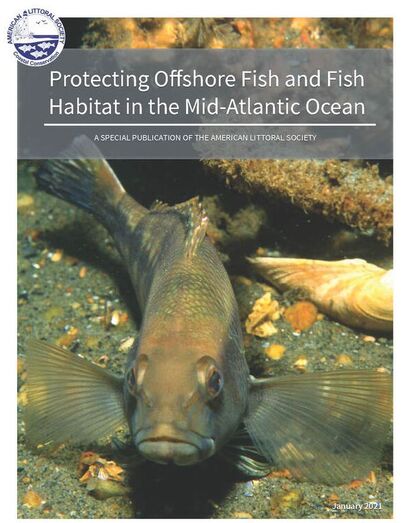 New Jersey - For almost sixty years, the American Littoral Society has worked to forge a path forward for coastal conservation and has done so, in large part, through the human connection to the ocean. Today, the organization is releasing a new report entitled “Protecting Offshore Fish and Fish Habitat in the Mid-Atlantic Ocean.” The report focuses on the management and protection of important habitat and fishing areas in the face of a changing climate and increasing demands for use of ocean spaces. The report can be found at the accompanying website ProtectFish.org. The report considers how the ocean is changing and how that impacts fishing. It takes a deep dive into New Jersey Prime Fishing Areas, special areas identified by the State of New Jersey that span along our Mid-Atlantic coastlines and open ocean, and how regulatory protections applied to those resources are implemented during the development and permitting of activities like offshore sand mining or wind development. The report also provides an overview of how Mid-Atlantic states from New York to Virginia protect fish and fish habitat through their federally approved Coastal Management Plans. “We hope this report will provide the public, anglers, and coastal managers with a set of insights and recommendations to strengthen regional and state planning approaches, rules and policies to protect fish and fish habitat in the face of increasing demands for the use of ocean space and resources, and a changing climate,” says Tim Dillingham, Executive Director. Climate change is impacting the Mid-Atlantic Bight and the larger Northeast Shelf Large Marine Ecosystem, placing crucial benefits and services like recreation, fishing, and coastal community safety and economies, to name a few, on the line. Recreational anglers and coastal managers see in real time fish shifting northward as ocean waters warm and acidify and conflicting uses mar or destroy important fish habitat.
“The ocean is under stress, which is worsened by climate change. Every single day we make demands on the ocean. Some demands have led to ecosystem degradation, overfishing, and polluted waters. On top of this, we see our ocean waters warming, acidifying, and losing oxygen, making life in the ocean harder for marine wildlife,” says Sarah Winter Whelan, Ocean Policy Program Director. “Now stack on top of that a rise in offshore shipping and ocean mining, while plans for large offshore wind energy projects become reality to help lead us into the clean energy future we need.” “All of this activity will create ripple effects to the health of our ocean and coasts for decades to come,” she says. “We explore some of those effects against existing regulatory protections for fish and fish habitat in this report as a way to help regulators find a path forward that protects fish and fish habitat in the face of these changes.” The demand for sand along Mid-Atlantic coastlines in the wake of disappearing beaches from intense storms and sea level rise has led to a hunt for offshore sand resources along the eastern seaboard. New Jersey anglers and the Littoral Society have long been concerned with the real identified impacts to offshore fish habitat from sand mining. In addition, the development of offshore wind in the Mid-Atlantic Bight is at the forefront of transitions to renewable energy from dirty fossil fueled energy sources in order to mitigate carbon dioxide emissions. The Society has long advocated that offshore wind must be sited and developed responsibly to prevent and mitigate impacts to the offshore environment. “Every Mid-Atlantic state has enforceable policies in their coastal management programs to protect fish and fish habitat, but how they are implemented varies. Some focus on types of ecosystems, some on coastal uses, and some on both,” states Helen Henderson, the Littoral Society’s Ocean Planning Manager. “What each has in common is the purpose of protecting important state coastal resources. We explored that further with a particular ocean stakeholder group, recreational anglers, and a specific state policy. We feel the angler insights shared about Prime Fishing Areas in this report, such as loss of habitat or habitat changes and use or development conflicts, are invaluable to decision-making in New Jersey and should also be at the forefront of regional ocean planning efforts.” Anglers consistently fish in and around these important places off the coast of New Jersey and have a wealth of information regarding the status, species, and use of these areas. Yet anglers have been historically under-consulted or consulted in an ad hoc and one-time manner for projects that will impact recreationally important species or their habitat. Outreach to engage recreational anglers was an important component of the American Littoral Society’s fish and fish habitat report. The organization worked with Stockton University’s Coastal Research Center to create maps from the Mid-Atlantic Ocean Data Portal showing New Jersey’s named Prime Fishing Areas identified along with additional ocean use details, such as offshore sand mining resources and wind lease areas. The maps were then used to conduct surveys, one-on-one interviews, and online workshops to learn more about the relationship between Prime Fishing Areas and anglers. The input gathered provided information about specific use conflict concerns; species information; and in-water knowledge about the impacts of past projects. The report also reviews various permit actions which identified inconsistencies in the application of the Prime Fishing Areas rule on various project decisions in New Jersey. “State and federal coastal managers analyzing coastal areas, potential projects and impacts would do well to increase the outreach and engagement to anglers. Decision-makers should engage anglers to better understand the ocean data portals, provide transparency and opportunities to be a part of how, whether, and when Prime Fishing Areas or similar areas should be studied and protected,” says Dillingham. The report not only provides angler insights but also identifies recommendations to assist decision-makers in New Jersey and beyond in closing knowledge and process gaps around state protections, like Prime Fishing Areas, that can lead to better understanding and protection of fish and fish habitat. “Our work finds that New Jersey and the region should focus on identifying and consistently protecting areas that exhibit the characteristics and recreational activity identified in the Prime Fishing Areas rule,” Dillingham says. “Other process improvements should be brought to the state and region including ease of project records access, improved coordinated regional planning with other Mid-Atlantic states and federal agencies, and increased stakeholder engagement.” “We believe that stakeholder engagement, initiated and carried out by states and federal agencies, is crucial to resource protection when planning and permitting projects,” Henderson adds. “In addition, further standards, location considerations, and review procedures in New Jersey should be strengthened and expanded upon and considered uniformly across states and in federal waters. Regionally, there would be great benefit to having maximum transparency in decision processes, open access to relevant records, and collaboration on data gaps and scientific research.” Comments are closed.
|
Archives
July 2024
Categories
All
|

